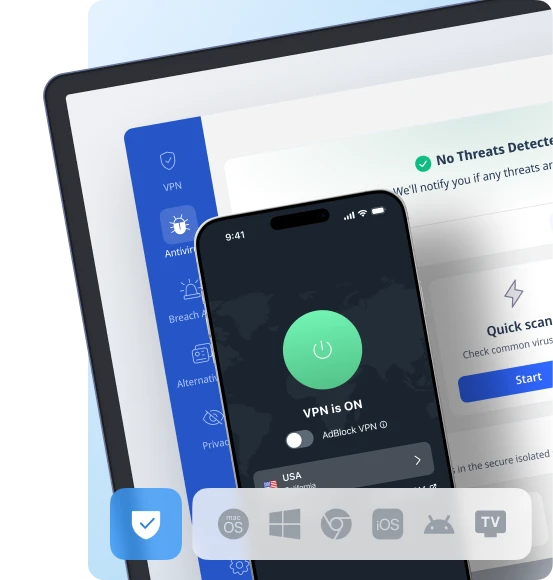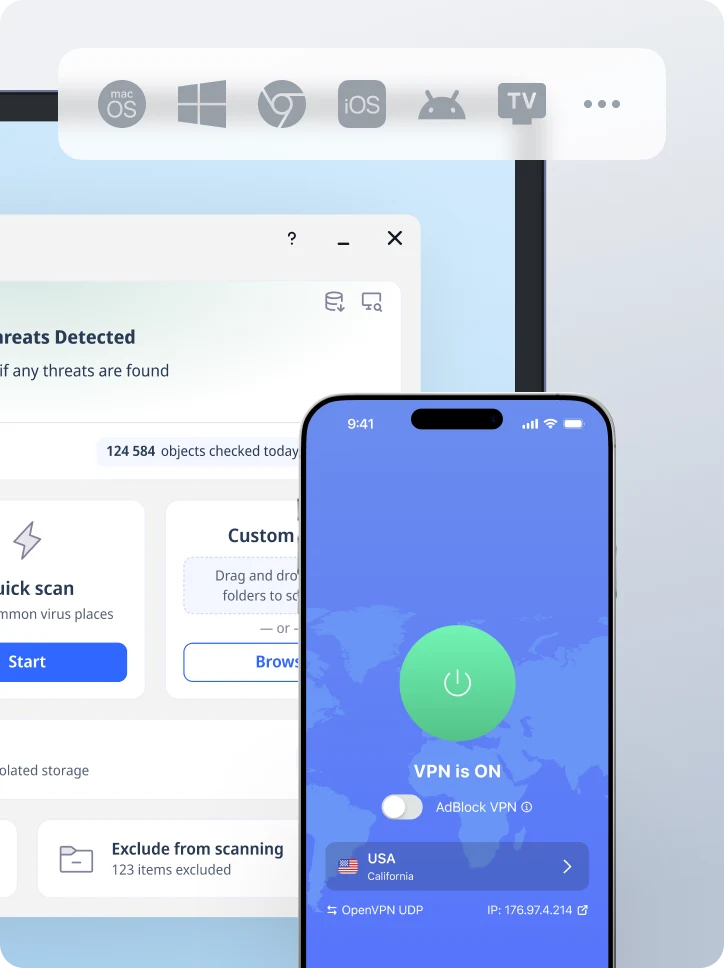How to Stop a DDoS Attack on Your Router
Distributed Denial of Service (DDoS) attacks have become one of the most common and annoying types of cyber attacks. They target everyone from individual gamers to big corporations, and often focus on groups that are typical targets of DDoS campaigns. These attacks can flood your Internet connection by sending an overwhelming amount of fake traffic to your router. The attacker, a malicious entity orchestrating the DDoS attack, uses various tools to direct this flood of data. As a result, legitimate users are unable to access online services, websites or games. But don’t panic, there are steps you can take to protect your home or office network. And right after you understand the danger, we’ll introduce you to one tool that boosts your digital defenses: VeePN.

Shield your network from the start with VeePN
Before we get into technical countermeasures, consider the simplest and most effective preventive step: using a VPN like VeePN. A VPN hides your real IP address, making it much harder for attackers to target your router directly. By hiding your real IP, VPNs prevent DDoS attacks, as attackers can’t easily find your network to launch an attack.
VeePN masks your online activity, reroutes traffic through encrypted tunnels and has servers in over 89 locations to dodge regional threats. With no data caps, 10 devices per account and advanced encryption protocols, VeePN is a stealth cloak for your entire network: the first line of defense against DDoS threats that protects your network infrastructure.
What is a DDoS attack and how does it affect your router?
In a DDoS attack, multiple compromised devices (often part of a botnet), botnets are networks of infected devices controlled by attackers simultaneously flooding your IP address with traffic requests, sending multiple requests at once to overwhelm your router. Your router, overwhelmed by this traffic tsunami, can’t process legitimate requests, resulting in network slowdowns, connection failures and potential long term damage.
This threat extends beyond individual routers to networks as a whole, making everything digital vulnerable.Your router is the most vulnerable because it’s the gateway between your devices and the internet and the attack is targeting the network behind the router. If a DDoS attack hits this point, your entire network will be inaccessible. A DDoS is a type of service attack that disrupts network services by flooding them with malicious traffic. Some signs of a DDoS attack include slow internet speeds, unable to access websites, sudden disconnections and a blinking or solid light pattern on your router indicating unusual activity. When a network is attacked in this way, it can experience severe disruptions and loss of connectivity.
Types of DDoS attacks you should know
DDoS attacks are of various forms, and each type is meant to interfere with your network in a different manner. Volumetric attacks, protocol attacks and application layer attacks are the most typical kinds of DDoS attacks.
With volumetric attacks, a massive traffic volume is directed to your network flooding your router and leading to denial of service by legitimate users.Protocol attacks take advantage of weaknesses in network protocols and attack the infrastructure keeping your network operating in a smooth manner. Application layer attacks are more specific whereby they seek to destroy specific services or applications through imitating normal traffic but at a level that the service or application cannot handle. Being aware of these forms of DDoS attacks, you will be more prepared to counteract them and make your network and services available to genuine users despite undergoing a DDoS attack.
How to stop a DDoS attack in progress
- Disconnect your internet connection: Temporarily unplug your modem or router to disrupt the attacker’s target. Using a router stop ddos approach, restarting your router can sometimes help stop or mitigate DDoS attacks especially if the attacker is targeting your current IP. This won’t stop the attack but it can pause its immediate effects and is one way to stop ddos attacks in progress.
- Change your IP address: If you have a dynamic IP, rebooting your router might assign a new one, giving you a new ip address that can help evade the attack. If you’re stuck with a static IP, contact your ISP to request a change to your static ip address. Managing and changing your ip addresses is crucial during a DDoS attack as it can help block attackers from targeting your network.
- 3. Enable router firewall settings: Log in to your router’s admin panel and turn on any built-in firewall or DDoS protection features. Using a firewall stop mechanism, firewalls can stop or mitigate DDoS attacks by filtering out malicious traffic. Modern routers often have traffic filtering tools that can help mitigate such attacks. Malicious IP addresses can be blocked using these tools to prevent attack traffic from reaching your network.
- Update your firmware: Manufacturers often release firmware updates to patch known vulnerabilities. Keeping your router up to date can close backdoors exploited by attackers.
- Contact your Internet Service Provider (ISP): ISPs occasionally will reroute your traffic, block malicious IPs or provide better DDoS mitigation services in case of bigger attacks. Internet service providers are a major stakeholder in DDoS mitigation, as they support and apply protections at the network level. ISPs are familiar with DDoS attacks and attacks and have advanced tools to aid in preventing, or assist you in responding to, the attacks.
When a ddos attack occurs, change your IP, enable firewalls and contact your ISP. Also consider the role of load balancers in your network as they can distribute traffic but can also be bypassed or introduce latency during a DDoS attack.
Firewall configuration: Your first line of defense
Probably the best method of blocking DDoS attacks before they cause damage is a well configured firewall. Firewalls serve as guards and they sieve incoming traffic and only authentic traffic can gain access to your network. You can avoid getting your router overwhelmed by malicious traffic by establishing rules to limit traffic coming in by unknown or suspicious sources.
The current firewalls also feature sophisticated DDoS protection capabilities of identifying abnormal traffic patterns and automatically preventing attack traffic. Further, the risk of a successful DDoS attack can be mitigated by limiting the incoming connection rate. Getting time to set your firewall accordingly can mean that your network is secure to unwanted traffic and that no one will have poor internet connection to all your devices.
IP address security: Hide your router from attackers
Hiding your IP address is a key step in preventing DDoS attacks on your router. DDoS attackers rely on knowing your IP address to target your network and launch attacks. Using a virtual private network (VPN) is one of the best ways to hide your real IP address as it encrypts your Internet traffic and routes it through secure servers making it hard for attackers to pinpoint your network.
Alternatively, a proxy server can act as a shield masking your IP address from malicious actors. If your ISP assigns you a dynamic IP address, rebooting your router can change your IP making it harder for attackers to maintain the attack. By hiding your IP address you make it much harder for DDoS attackers to find and target your router and keep your network safe from unwanted traffic.
Prevent future DDoS attacks with these long term strategies
To protect your home, office and all types of networks from most DDoS attacks implement these long term strategies for robust defense:
✅Use a VPN (like VeePN): This reduces the chances of your real IP being exposed.
✅Configure your router with strong credentials: Default usernames and passwords are hacker bait. Change them immediately.
Older routers may lack essential security features and are more vulnerable to attacks. Update firmware regularly or replace older routers to enhance your network’s protection.
✅Enable MAC address filtering: Only allow specific devices to connect to your network, prevent unauthorized devices from connecting.
✅Disable UPnP: While convenient UPnP can expose ports that hackers exploit.
Malware can exploit open ports and vulnerabilities making it easier for attackers to launch DDoS attacks. Regularly scan for and remove malware to maintain network security.
✅Monitor bandwidth usage: Use apps or router tools to detect unusual spikes. For effective traffic analysis use monitoring tools and protocols that your router supports. Maintaining these security tools requires a lot of resources and ongoing effort.
✅Segment your network: Isolate critical devices on separate subnets to prevent complete disruption. Securing wireless networks such as your home Wi-Fi with strong passwords and updated firmware is essential for overall DDoS defense. Most attacks can be mitigated with proper segmentation and continuous monitoring.
Inadequate DDoS protection can result to financial losses due to downtime, lost productivity and potential damage to your reputation.
DDoS attack recovery: What to do
The process of regaining access to the internet after a DDoS attack is not all about restoring your connection to the Internet, but building up your defenses so as to ensure that future attacks are not a possibility. To start, you should check your log files and examine the flow of traffic in the network to see the nature and origin of the attack. This will assist you in knowing how the attack happened and the vulnerable points used in the attack.
Then, update the firewall settings and think of using some more DDoS protection services so that in the future such attacks could be prevented. Ensure all your devices, software and firmware are up-to-date to seal security vulnerabilities. Continuous surveillance of the network and system performance is also necessary to enable prompt identification of any indication of another attack. Through them you can overcome a DDoS attack and develop a stronger network and be safe against future attacks.
Why VeePN is your best ally against DDoS attacks
VeePN doesn’t just anonymize your IP; it’s a complete security ecosystem. It has military-grade AES-256 encryption, DNS leak protection and a Kill Switch to stop Internet activity if the VPN connection drops—so no data gets exposed. Its worldwide server coverage allows you to bypass congested routes and be regionally targeted. And with strict No Logs policy your online footprint remains untraceable.
How to set up VeePN on your router
- Log in to your router’s admin panel.
- Go to the VPN section (usually under Advanced Settings).
- Choose “OpenVPN” or “L2TP/IPSec” as your protocol.
- Enter the server details and credentials provided by your VeePN account.
- Save settings and reboot your router.
Once installed every device connected to your router will have VeePN protection by default.
Final thoughts: Don’t wait for an attack to act
A DDoS attack on your router can feel overwhelming but with proactive security habits and tools like VeePN you can reduce your exposure dramatically. Whether you’re a gamer, remote worker or everyday internet user, protecting your router isn’t just optional — it’s mandatory.
Ready to guard your digital home? Try VeePN today and turn your router into a fortress.
VeePN is freedom
Download VeePN Client for All Platforms
Enjoy a smooth VPN experience anywhere, anytime. No matter the device you have — phone or laptop, tablet or router — VeePN’s next-gen data protection and ultra-fast speeds will cover all of them.
Download for PC Download for Mac IOS and Android App
IOS and Android App
Want secure browsing while reading this?
See the difference for yourself - Try VeePN PRO for 3-days for $1, no risk, no pressure.
Start My $1 TrialThen VeePN PRO 1-year plan








